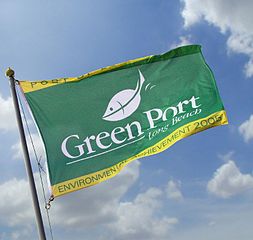Along with California’s San Joaquin Valley, the South Coast air basin is known notoriously for having the poorest quality air in the entire United States. A title like that no place wants.
So, when an entity aspires to want to not just change but improve the environment in which it exists, operates, conducts business, it should be cheered on.

For you see, this entity proposes to change to improve the way operations are conducted at one of its terminals – Pier B.
The Port proposes redoing the terminal area (facility) to allow exclusive (no trucks) rail access. The idea here is to improve efficiencies at the terminal area.
Along with this, a direct port-area air benefit will result. If you want to know how, the answer is simple.
Huge cranes lower containers brought from overseas on container ships docked portside. Containers handled by truck for forwarding, redistributing, relocating, or temporary storage elsewhere, unless the truck tractors responsible for moving said containers around the port complex are emissions-free, each move further adds pollutant emissions to the surrounding air.
As a way to lessen the negative air impact, each container could instead be loaded onto (or unloaded from) a waiting railroad flat- or double-stack car – not independently (as is the case with the truck moves), but in tandem with additional flat-/double-stack cars (two per car in the case of the double-stack well cars; one placed atop the other). Once that process is complete, strings of container cars could be rail-shuttled to the next location in the shipping/forwarding sequence.
Moreover, if the locomotives providing the muscle to move flatcar/stackcar strings are cleaner-burning where their prime movers are concerned, the air benefit would be even greater.
Well, something along these very lines is what the Port of Long Beach proposes for its Pier B terminal.
On this, the Port of Long Beach had this to say.

Truck moves at that terminal, according to the Port, would become a thing of the past. Container trains would be assembled at first into shorter-length ones, only to later be made up into full-length trains.
“The rail yard would be operated by Pacific Harbor Line, which provides short haul rail transportation switching services, railroad track maintenance and train dispatching services under contract to the Port. Pacific Harbor Line is the first railroad in the nation that has converted its entire fleet to clean diesel locomotives that reduce air pollution and save fuel,” the POLB went on in the release to state. (For related information, see: “Lower emissions diesel loco to head to Pacific Harbor Line for testing” here).
There is more on this at: www.polb.com/PierB.
Meanwhile, according to the POLB’s Jan. 27, 2017 “Public Input Period Extended for Rail Facility Study,” news release, public comment on the proposal was being accepted until March 13, 2017.
I plan to provide regular updates on this action as information becomes available.
Middle image above: William Grimes
This post was last revised on Apr. 23, 2020 @ 7:02 a.m. Pacific Daylight Time.
– Alan Kandel
